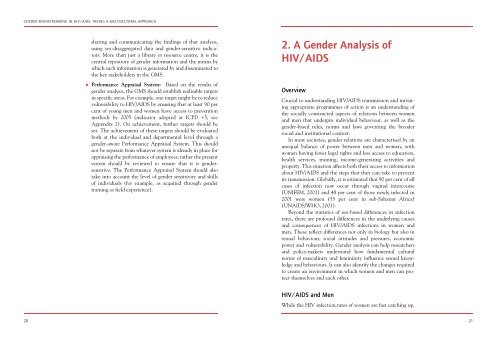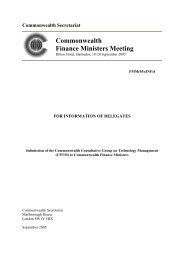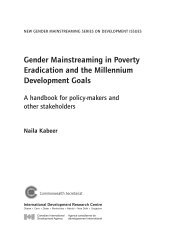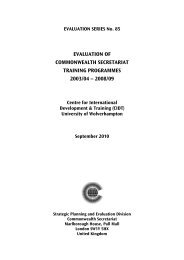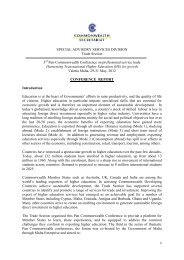Gender Mainstreaming in HIV/AIDS - Commonwealth Secretariat
Gender Mainstreaming in HIV/AIDS - Commonwealth Secretariat
Gender Mainstreaming in HIV/AIDS - Commonwealth Secretariat
You also want an ePaper? Increase the reach of your titles
YUMPU automatically turns print PDFs into web optimized ePapers that Google loves.
GENDER MAINST R E A M I NG IN <strong>HIV</strong>/<strong>AIDS</strong>: TA K I NG A MULT I S E C TORAL APPROACH<br />
shar<strong>in</strong>g and communicat<strong>in</strong>g the f<strong>in</strong>d<strong>in</strong>gs of that analysis,<br />
us<strong>in</strong>g sex-disaggregated data and gender-sensitive <strong>in</strong>dicators.<br />
More than just a library or resource centre, it is the<br />
central repository of gender <strong>in</strong>formation and the means by<br />
which such <strong>in</strong>formation is generated by and dissem<strong>in</strong>ated to<br />
the key stakeholders <strong>in</strong> the GMS.<br />
• Performance Appraisal System: Based on the results of<br />
gender analysis, the GMS should establish realisable targets<br />
<strong>in</strong> specific areas. For example, one target might be to reduce<br />
vulnerability to <strong>HIV</strong>/<strong>AIDS</strong> by ensur<strong>in</strong>g that at least 90 per<br />
cent of young men and women have access to prevention<br />
methods by 2005 (<strong>in</strong>dicator adopted at ICPD +5, see<br />
Appendix 2). On achievement, further targets should be<br />
set. The achievement of these targets should be evaluated<br />
both at the <strong>in</strong>dividual and departmental level through a<br />
gender-aware Performance Appraisal System. This should<br />
not be separate from whatever system is already <strong>in</strong> place for<br />
apprais<strong>in</strong>g the performance of employees; rather the present<br />
system should be reviewed to ensure that it is gendersensitive.<br />
The Performance Appraisal System should also<br />
take <strong>in</strong>to account the level of gender sensitivity and skills<br />
of <strong>in</strong>dividuals (for example, as acquired through gender<br />
tra<strong>in</strong><strong>in</strong>g or field experience).<br />
2. A <strong>Gender</strong> Analysis of<br />
<strong>HIV</strong>/<strong>AIDS</strong><br />
Crucial to understand<strong>in</strong>g <strong>HIV</strong>/<strong>AIDS</strong> transmission and <strong>in</strong>itiat<strong>in</strong>g<br />
appropriate programmes of action is an understand<strong>in</strong>g of<br />
the socially constructed aspects of relations between women<br />
and men that underp<strong>in</strong> <strong>in</strong>dividual behaviour, as well as the<br />
gender-based rules, norms and laws govern<strong>in</strong>g the broader<br />
social and <strong>in</strong>stitutional context.<br />
In most societies, gender relations are characterised by an<br />
unequal balance of power between men and women, with<br />
women hav<strong>in</strong>g fewer legal rights and less access to education,<br />
health services, tra<strong>in</strong><strong>in</strong>g, <strong>in</strong>come-generat<strong>in</strong>g activities and<br />
property. This situation affects both their access to <strong>in</strong>formation<br />
about <strong>HIV</strong>/<strong>AIDS</strong> and the steps that they can take to prevent<br />
its transmission. Globally, it is estimated that 90 per cent of all<br />
cases of <strong>in</strong>fection now occur through vag<strong>in</strong>al <strong>in</strong>tercourse<br />
(UNIFEM, 2001) and 48 per cent of those newly <strong>in</strong>fected <strong>in</strong><br />
2001 were women (55 per cent <strong>in</strong> sub-Saharan Africa)<br />
(UN<strong>AIDS</strong>/WHO, 2001).<br />
Beyond the statistics of sex-based differences <strong>in</strong> <strong>in</strong>fection<br />
rates, there are profound differences <strong>in</strong> the underly<strong>in</strong>g causes<br />
and consequences of <strong>HIV</strong>/<strong>AIDS</strong> <strong>in</strong>fections <strong>in</strong> women and<br />
men. These reflect differences not only <strong>in</strong> biology but also <strong>in</strong><br />
sexual behaviour, social attitudes and pressures, economic<br />
power and vulnerability. <strong>Gender</strong> analysis can help researchers<br />
and policy-makers understand how fundamental cultural<br />
norms of mascul<strong>in</strong>ity and fem<strong>in</strong><strong>in</strong>ity <strong>in</strong>fluence sexual knowledge<br />
and behaviours. It can also identify the changes required<br />
to create an environment <strong>in</strong> which women and men can protect<br />
themselves and each other.<br />
While the <strong>HIV</strong> <strong>in</strong>fection rates of women are fast catch<strong>in</strong>g up,<br />
20 21


